Predicting Soft Soil Settlement with a FAGSO-BP Neural Network Model †
Abstract
:1. Introduction
2. Principles of Optimization Neural Networks
- (1)
- Key parameter coding: In neural networks, weights and thresholds exist as multidimensional vector arrays spanning the parameter space. Let , X denotes a set of parameters consisting of network weights and thresholds. In network, denote , as the number of weights between the implicit layer and the input layer and the output layer and the implicit layer, , are the number of implicit layer and output layer thresholds, denote + + , D is the total set of weights and thresholds.
- (2)
- Calculation of adaptation values: the neuronal weights and neuronal thresholds within each layer of the feedforward architecture are parameterized through a stochastic initialization process, where all values are uniformly sampled from the interval [−1,1] following the relationship, i.e., , and use the position of the firework individual in the firework algorithm to represent the weights between the network nodes and the thresholds at each layer.
- (3)
- Define the fitness function: Selection of squared errors to assess the fitness value of the FAGSO-BP model, Equation (1) was used to calculate the fitness value of individual fireworks. Calculation of the actual output value of the network was done using Equation (2) and calculation of the fitness function value was done through Equation (3) as follows:where t is the target output value to be achieved by the network; P is total number of layers of the neural network; S is the number of nodes in the output layer; y is the output result actually calculated by the network.where is the input to the network; is the weights of the network nodes; is the threshold for the first neuron in the network.
- (4)
- Optimization of firework populations: For each individual firework , calculate its fitness value through Equation (3). To determine the quantity of fireworks that burst, utilize Equations (4) and (5) for computation and using Equations (6)–(8) for blast, displacement and mutation operations, and make Equation (9) select the optimal fireworks individuals to form the next generation of fireworks population as follows:where denotes the number of sparks released by the ith firework; m is a constant that regulates the total number of sparks generated by the entire population during the initialization phase; represents the fitness value of the least fit (i.e., the worst-performing) individual in the current population; is the individual ith firework’s fitness function value; is a tiny positive number introduced to prevent the divisor from being zero.where is the range of explosion amplitude of fireworks; is a constant limiting the explosion amplitude of fireworks; denotes the fitness value corresponding to the individual with the best fitness in the current population.where h is the positional bias term in each dimension; is the kth dimension of the ith firework; is the exploding spark; is a Gaussian variant spark; r is a random number obeying a Gaussian distribution r~N (1,1).where denotes the cumulative value of the distance between an individual and the rest of the individuals in the population.
- (5)
- Determine the inertial weight for each particle utilizing Equations (10) and (11) within the search domain, and the 2 × N particles with the best mass among them are selected to form an elite set of particles R as follows:
- (6)
- Calculate the Euclidean distances of the elite particles from the other particles in the set R, and the magnitude of the stress in the d-dimension for each particle is calculated from Equations (12) and (13); in this network model d = 4. Generate new spark particles according to Equation (14) and the particles that are out of range are mapped according to Equation (15). All the spark particles and fireworks are sorted according to the size of the fitness value, from which the top N elite particles are selected for constituting the initial population of fireworks in the next iteration, set t = t × 1, as follows:where and are coordinate values corresponding to the ith and jth particles in the set in dimension d (); is the combined force of particle i in the dth dimension; G indicates the constant used to adjust the accuracy of the particle position update; denotes the inertial mass parameter of the particle itself; represents the distance in Euclidean terms between particles i and j; are the upper and lower bounds in the kth dimension.
- (7)
- If t < T, then return to step (4), otherwise the algorithm stops. Calculate the fitness value for each individual firework x according to Equation (3), the firework individual with the minimum fitness value in the current firework population is taken as the optimal firework individual .
- (8)
- To update the weights and thresholds, the weights and thresholds in the BP neural network are initialized using firework individuals . The weights and threshold vectors X in the network model are updated by the BP neural network.
3. Neural Network Model Building and Validation
3.1. Data Sources
3.2. Data Normalization
3.3. Determination of Neural Network Parameters
- (1)
- Determination of structural parameters of BP neural network
- (2)
- Determination of the number of iterations of the fireworks algorithm
- (3)
- Determination of the population size of the fireworks algorithm
- (4)
- Determination of the number of Gaussian variant sparks for fireworks algorithms
3.4. Optimizing Neural Network Feasibility Analysis
4. Example Analysis
- Cultivated soil ①: plastic high compressibility soil, plant roots and corrosive material content of about 5%, physical and mechanical properties of large differences, poor structure, cannot be used as the road foundation bearing layer, should be dug out.
- Powdery clay ②: according to the results of geotechnical tests and field standard penetration test results for the hard plastic compressive soil, physical and mechanical properties are better, shallower buried, strength is more uniform, can be selected as the road natural foundation holding layer.
- Powdery clay ③: according to the results of geotechnical test and on-site standard penetration test results for soft-plastic high compression soil, its soil quality is poor, low strength, can be selected as a composite foundation pile foundation bearing layer.
- Fine sand ④: saturated with water, slightly dense according to standard penetration test, with general physical and mechanical properties, but with deeper burial and smaller thickness, it cannot be selected as bearing layer of foundation pile.
- Pebbles ⑤: saturated with water, in dense state, with better physical and mechanical properties, smaller deformation, more stable distribution, but deeper buried, can be selected as bearing layer of pile foundation of proposed road foundation.
4.1. Optimization Neural Network Model Building
- (1)
- Time of observation: measured data.
- (2)
- Groundwater level: measured data.
- (3)
- Soft soil roadbed disposal methods: (1) cement mixing pile; (2) dredgings and replenishment; (3) biochemical enzyme curing; (4) high pressure rotary spraying piles.
- (4)
- Monitoring locations: (1) general roadbed; (2) access road; (3) access road transition section; (4) round pipe culvert; (5) bridgehead transition section; (6) bridgehead encryption section; (7) bridgehead treatment section.
4.2. Model Training and Testing
- (1)
- RMSE (Root Mean Square Error): Measures the average error between the predicted value and the actual value. The smaller the RMSE, the more accurate the prediction of the model.
- (2)
- MAE (Mean Absolute Error): Measures the average of the absolute errors between the predicted and actual values. The smaller the MAE, the more accurate the model’s predictions.
- (3)
- MAPE (Mean Absolute Percentage Error): Measures the average of the absolute percentage error between the predicted value and the actual value. The smaller the MAPE, the more accurate the model’s prediction.
- (4)
- MSE (Mean Square Error): Measures the average of the squares of the errors between the predicted values and the actual values. The smaller the MSE, the more accurate the prediction of the model.
- (5)
- Mean Relative Error (%): Measures the average value of the relative error between the predicted and actual values. The smaller the average relative error, the more accurate the model’s prediction.
4.3. Projected Results
5. Conclusions
- (1)
- The feasibility of the FWA-BP neural network prediction model and the FAGSO-BP neural network prediction model were verified using the monitoring data of the deep foundation pit project of the West Third Ring Road in Zhengzhou City. The results show that the maximum relative error of FWA-BP neural network is −5.3785%, the minimum relative error is 0.5790% and the average relative error is −1.7221%. The maximum relative error of FAGSO-BP neural network is −3.8961%, the minimum relative error is 0.0447% and the average relative error is −1.6106%. Compared with the single BP neural network, the prediction accuracy of FWA-BP and FAGSO-BP neural network is improved, the prediction accuracy of FWA-BP is approximately equal to that of GA-BP neural network, and the prediction accuracy of FAGSO-BP neural network is slightly better than that of GA-BP neural network, which proves that the optimization approach is feasible.
- (2)
- Through the soft foundation settlement prediction analysis of Hunan Wuyi Expressway Project, it can be seen that among the four neural network prediction models, the FAGSO-BP neural network model shows a lower average relative error (6.06%), mean square error MSE (2.56) and root mean square error RMSE (1.60), their reductions of 34.63%, 47.33% and 27.27%, respectively, compared to BP neural network, which verifies the efficiency and reliability of the model in real engineering projects.
- (3)
- By applying a combination of the fireworks algorithm and the gravitational search operator to the BP neural network, the proposed FAGSO-BP model performs well in terms of weight and threshold optimization, which indicates that the algorithm optimization can effectively improve the accuracy of soft ground settlement prediction. Compared with the traditional BP neural network, GA-BP neural network and FWA-BP neural network, the FAGSO-BP model has smaller errors and higher stability, which indicates that the introduced optimization algorithm is able to enhance the robustness of the model for soft ground settlement prediction.
- (4)
- Future work can focus on the following three aspects:① fusion of spatio-temporal modelling techniques (e.g., LSTM-Transformer) to enhance long-term prediction capability under dynamic loading; ② development of adaptive parameter optimization framework to expand the generalization of the model to complex geologies, such as oceanic clays, organic soils, etc.; ③ construction of real-time subsidence early warning system by combining edge computing with multi-source sensing data (InSAR, fibre optics), to promote intelligent geotechnical engineering management.
Author Contributions
Funding
Data Availability Statement
Conflicts of Interest
Abbreviations
| FAGSO | Fireworks Algorithm with Gravitational Search Operator |
| BP | Backpropagation Neural Network |
| GA | Genetic Algorithm |
| FWA | Fireworks Algorithm |
| PSO | Particle Swarm Optimization |
| RBF | Radial Basis Function |
| HO | Hippopotamus Optimization Algorithm |
| DE | Differential Evolution |
References
- Wu, Q. Design and application practice of composite process for soft foundation treatment of modern logistics and warehousing floors. Build. Struct. 2021, 51, 1894–1898. [Google Scholar]
- Chen, Y. Research on Vibration, Cumulative Deformation Characteristics and Design Method of Highway in Soft Soil Area. Ph.D. Thesis, Zhejiang University, Hangzhou, China, 2018. [Google Scholar]
- Gao, L.; Dai, G.; Yao, Z.; Zhang, J.; Wang, A.; Chen, H. Experimental study on horizontal bearing performance of large diameter monopile in hydraulic soil. J. Southeast Univ. 2024, 54, 142–148. [Google Scholar]
- Rong, Z. On the research existing situation of the settlement analysis of soft soil foundation. Shanxi Archit. 2008, 34, 139–140. [Google Scholar]
- Zhang, J. Research on Motor Bearing Fault Diagnosis Based on Multi-Scale Entropy Features and Integrated Learning. Master’s Thesis, Anhui University of Technology, Maanshan, China, 2024. [Google Scholar]
- Liu, Y.; Liao, S.; Du, H.; Bai, L.; Zhong, R. Research on intelligent prediction and control method of metro shield tunneling parameters based on machine learning. Railw. Stand. Des. 2023, 67, 137–145+154. [Google Scholar]
- Lv, S.; Zhang, G. A clustering method incorporating K-means algorithm and artificial fish swarm algorithm. Comput. Appl. Softw. 2015, 32, 240–243+279. [Google Scholar]
- Tian, T.; Qiu, R.; Zhao, L.; Geng, J.; Wang, E.; Sun, Y. Optimal network modelling for software reliability growth of quantum DC energy meters. Electr. Meas. Instrum. 2025, 62, 217–224. [Google Scholar]
- Yang, Q.; Wang, P. Prediction of uniaxial compressive strength of granite based on BP neural network. Chem. Miner. Geol. 2025, 47, 78–82. [Google Scholar]
- Shan, X.; Liu, Z.; Xin, N.; Hou, J.; Yao, L.; Wang, Y. Research on traffic accident combination prediction model based on game theory comprehensive empowerment improvement. Mod. Electron. Technol. 2025, 48, 120–126. [Google Scholar]
- Liu, Y.J.; Li, Z.M.; Wang, Y.; Liu, Y.M.; Chen, Y.J.; Lin, H. Study on Deformation Property of Soft Soil Based on Neural Networks. Appl. Mech. Mater. 2013, 353–356, 270–273. [Google Scholar] [CrossRef]
- Li, M.; Zhang, Y.; Wang, C. Soft Subgrade Settlement Prediction by Generic-Neutral Network. Drill. Eng. 2009, 36, 45–47. [Google Scholar]
- Wang, J.; Zhao, R.; Yuan, W. Application of BP neural network Factor screening based onselected by genetic algorithmin data processing of soft soil subgradesub-grade settlement. Mine Surv. 2016, 44, 87–90. [Google Scholar]
- Zhou, W.; Wang, Q. Prediction of Subgrade Settlement Based on GA-BP Neural Network. Land Resour. Her. 2022, 19, 76–80. [Google Scholar]
- Wang, B.; Yang, Z.; Dong, L. Cost prediction of masonry structure demolition based on GA-BP neural network. J. Jilin Jianzhu Univ. 2021, 38, 7–11. [Google Scholar]
- Li, M.; Sun, X.; Zhao, W.; Wang, T. Application of optimal grey BP neural network combination model in foundation pit settlement monitoring. J. Jilin Jianzhu Univ. 2023, 40, 25–30. [Google Scholar]
- Guo, Z. Stability Analysis of Excavation Face of Shield Tunnel in High Water-Rich Soft Soil. Master’s Thesis, Taiyuan University of Technology, Taiyuan, China, 2020. [Google Scholar]
- Zhang, G. Research on Deformation Prediction Method and Safety Evaluation of Deep Foundation Pit; Hebei University of Architecture: Zhangjiakou, China, 2022. [Google Scholar]
- Wang, B.; Meng, F.; Zeng, C.; Guo, G.; Liu, X. Landslide reliability evaluation method based on PSO-BP neural network with natural selection strategy. J. China Foreign Highw. 2019, 39, 1–9. [Google Scholar]
- Zhang, C.; Zhang, Z.; Yin, L.; Zhang, L.; Lu, X. A roadbed settlement prediction model based on improved particle swarm neural network. J. China Foreign Highw. 2020, 40, 110–113. [Google Scholar]
- Wi, Y.; Zhang, C.; Zhang, H. Research on reservoir slope deformation prediction based on optimised BP neural network of hippo algorithm. Water Conserv. Hydropower Technol. 1–23.
- Yao, Y.; Yan, Y.; Sun, B.; Wang, Y.; Jiang, T. Inverse analysis of thermal parameters of concrete box girder based on DE-BP neural network. J. China Foreign Highw. 1–12.
- Ma, C.; Shao, J. Prediction Model Based on lmproved BP Neural Network with Fireworks Algorithm and Its Application. Control. Eng. China 2020, 27, 1324–1331. [Google Scholar]
- Zhang, S.; Lin, X.; Hong, Y.; Feng, Y.; Wu, F. Optimized back propagation neural network based on whale algorithm for simulated prescription prediction of Chinese medicine placebo solution colour. Chin. J. Tradit. Chin. Med. 2024, 49, 4437–4449. [Google Scholar]
- Wang, W.; Yang, W.; Han, Y.; An, Y.; Hao, J.; Zhang, Q.; Ju, C. Orthogonal experiments combined with AHP and GA-BP neural network to optimise the alcoholic extraction process of Yi Huang San. Chin. Pharm. 2024, 35, 327–332. [Google Scholar]
- Zhang, X.; Fan, C.; He, A.; Wu, C.; Yang, Y. Performance prediction and structural parameter optimisation of control rod hydrodynamic buffer based on GA-BP neural network. Nucl. Power Eng. 2023, 44, 162–169. [Google Scholar]
- Tan, Y.; Zheng, S. Recent advances in fireworks algorithm. CAAI Trans. Intell. Syst. 2014, 515–528. [Google Scholar]
- Rashedi, E.; Nezamabadi, H.; Saryazdi, S. GSA:A gravitational search algorithm. Inf. Sci. 2009, 179, 2232–2248. [Google Scholar] [CrossRef]
- Zhu, Q.; Wang, Z.; Huang, M. Fireworks algorithm with gravitational search operator. Control. Decis. 2016, 31, 1853–1859. [Google Scholar]
- Ma, B.; Zhao, Z.; Deng, X.; Lan, T.; Du, B.; Xiao, Y. FAGSO-BP neural network model for settlement prediction of soft soil foundation. In Proceedings of the 5th GeoShanghai 2024 International Academic Conference, Shanghai, China, 26–29 May 2024. [Google Scholar] [CrossRef]
- Fan, X. Deformation Prediction of Deep Foundation Pit based on GA-BP and Security Risk Assessment Research. Master’s Thesis, Zhengzhou University, Zhengzhou, China, 2021. [Google Scholar]
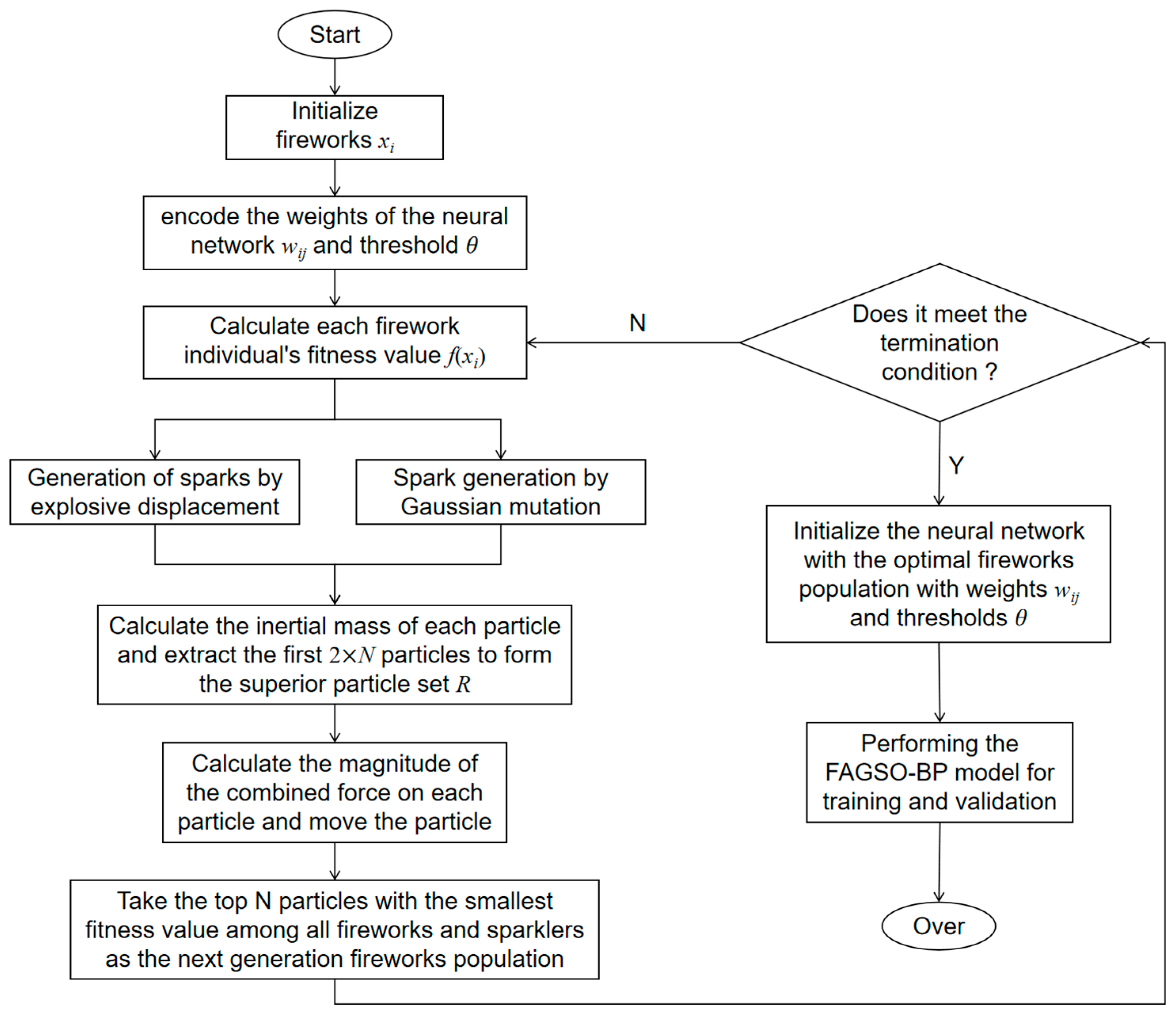
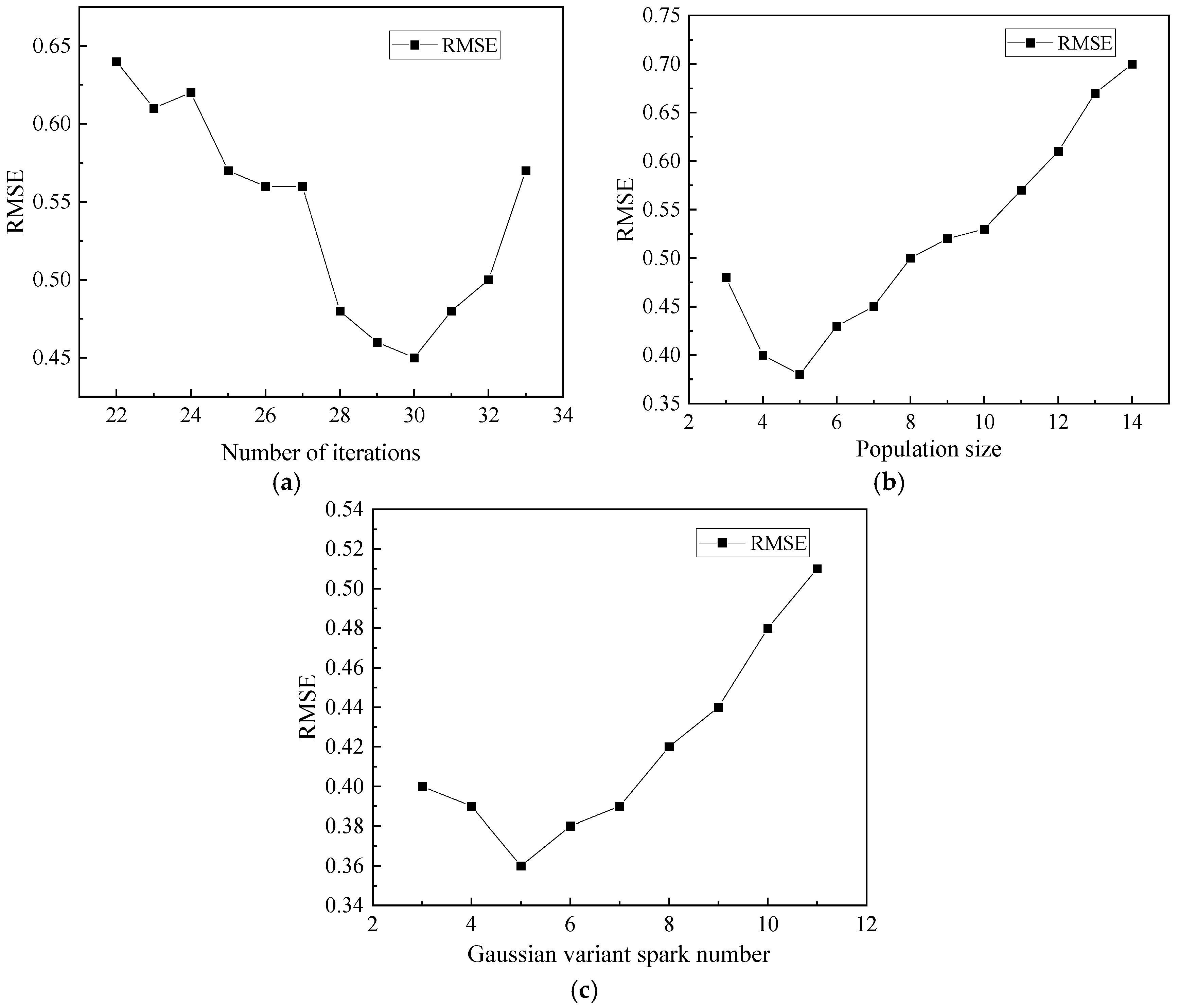
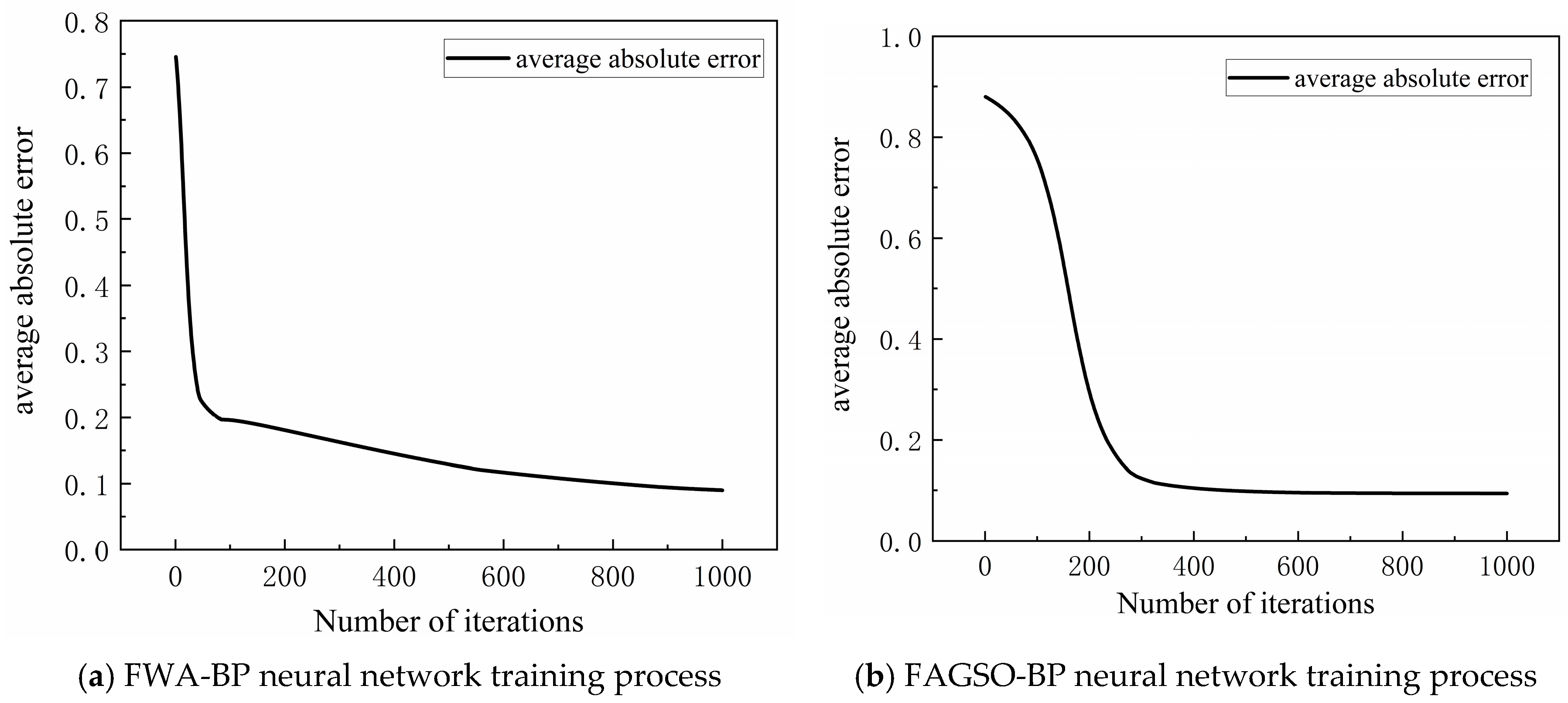

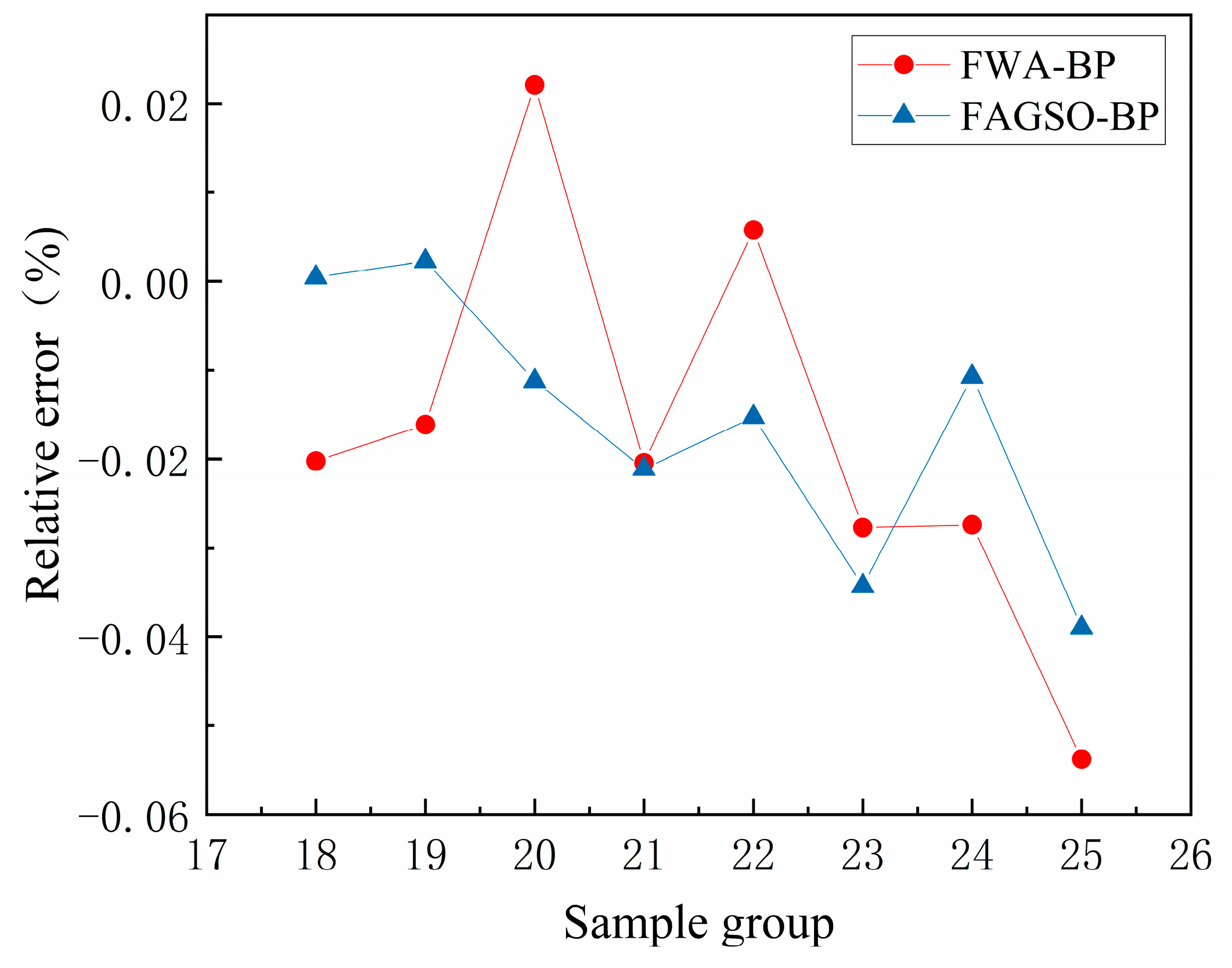
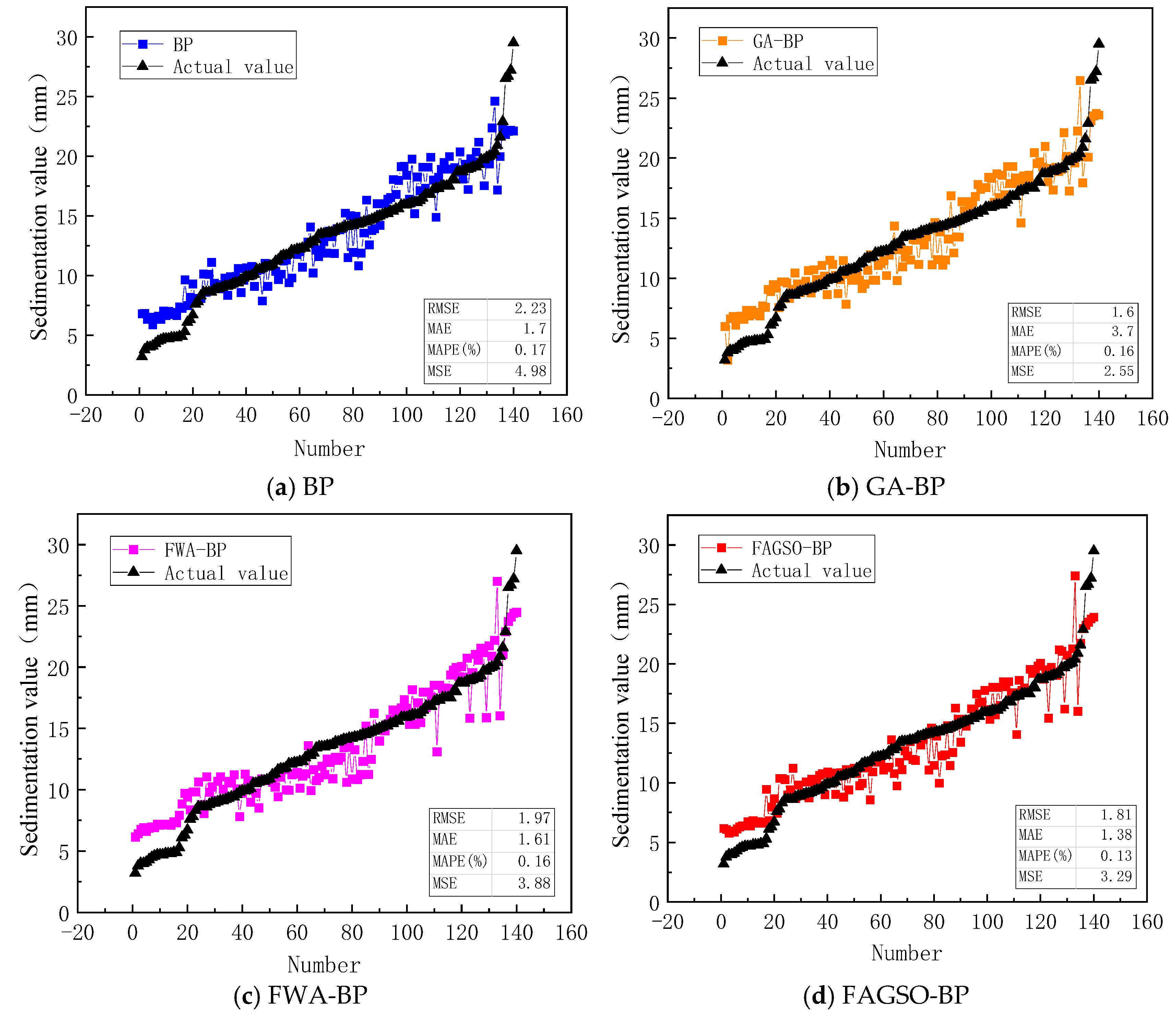
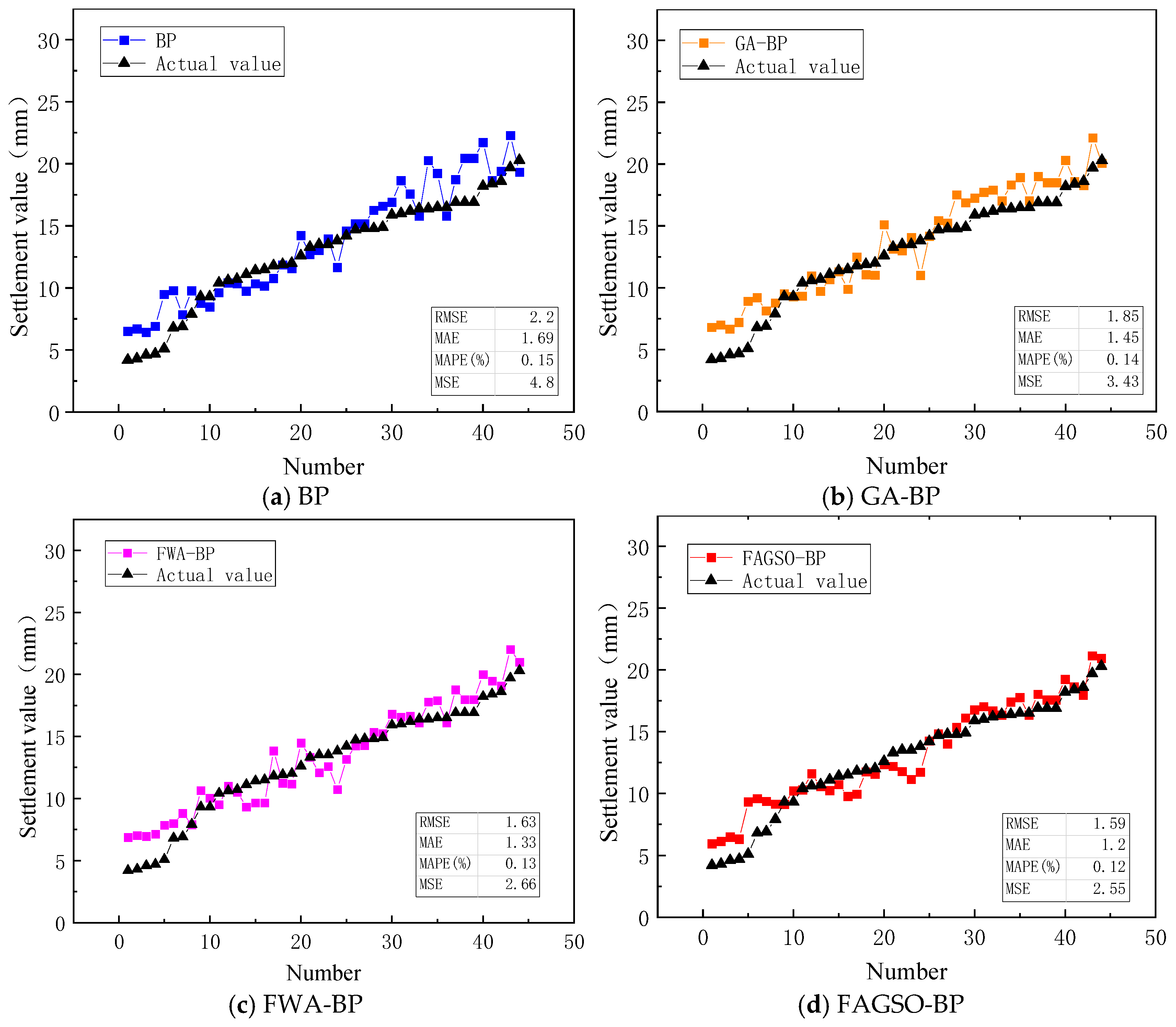
| Parameter Name | Parameter Overview | Corresponding Value |
|---|---|---|
| m | Quantity of neurons in the input layer | 4 |
| n | Neuron count in the hidden layer | 10 |
| s | Total nodes in the output layer | 1 |
| lr | The learning rate of the network | 0.001 |
| epochs | Training maximum number of iterations | 1000 |
| goal | Training target minimum error | 0.00065 |
| Parameter Name | Parameter Description | Parameter Value |
|---|---|---|
| N | Size in populations of fireworks | 5 |
| d | The radius of fireworks was adjusted by a constant | 10 |
| m | The number of fireworks exploding sparks was adjusted by a constant | 5 |
| am | The upper bounds for the number of fireworks exploding sparks | 6 |
| bm | The lower bounds for the number of fireworks exploding sparks | 2 |
| g | The number of Gaussian variant sparks | 5 |
| T | Maximum iterations | 30 |
| Sample Group | Monitoring Value (mm) | FWA-BP Prediction (mm) | Average Relative Error (%) | FAGAO-BP Prediction (mm) | Average Relative Error (%) |
|---|---|---|---|---|---|
| 18 | 6.89 | 6.75 | −1.7221 | 6.89 | −1.6106 |
| 19 | 7.03 | 6.92 | 7.05 | ||
| 20 | 7.35 | 7.51 | 7.17 | ||
| 21 | 7.53 | 7.38 | 7.27 | ||
| 22 | 7.68 | 7.72 | 7.36 | ||
| 23 | 7.89 | 7.67 | 7.42 | ||
| 24 | 7.96 | 7.74 | 7.47 | ||
| 25 | 8.23 | 7.79 | 7.51 |
| Parameter Name | Parameter Description | Parameter Value |
|---|---|---|
| popu | Population size | 5 |
| gen | Hereditary number | 200 |
| pcross | Crossover probability | 0.08 |
| permutation | Mutation probability | 0.002 |
| Metrics | Network Type | |||
|---|---|---|---|---|
| BP | GA-BP | FWA-BP | FAGSO-BP | |
| RMSE | 2.23 | 1.60 | 1.97 | 1.82 |
| MAE | 1.70 | 3.77 | 1.62 | 1.39 |
| MAPE (%) | 0.17 | 0.16 | 0.17 | 0.14 |
| MSE | 4.98 | 2.55 | 3.89 | 3.29 |
| Average relative error (%) | 7.41 | 7.09 | 6.91 | 5.54 |
| Metrics | Network Type | |||
|---|---|---|---|---|
| BP | GA-BP | FWA-BP | FAGSO-BP | |
| RMSE | 2.20 | 1.85 | 1.63 | 1.60 |
| MAE | 1.69 | 1.46 | 1.33 | 1.20 |
| MAPE (%) | 0.16 | 0.15 | 0.14 | 0.12 |
| MSE | 4.86 | 3.44 | 2.67 | 2.56 |
| Average relative error (%) | 9.27 | 9.74 | 7.03 | 6.06 |
Disclaimer/Publisher’s Note: The statements, opinions and data contained in all publications are solely those of the individual author(s) and contributor(s) and not of MDPI and/or the editor(s). MDPI and/or the editor(s) disclaim responsibility for any injury to people or property resulting from any ideas, methods, instructions or products referred to in the content. |
© 2025 by the authors. Licensee MDPI, Basel, Switzerland. This article is an open access article distributed under the terms and conditions of the Creative Commons Attribution (CC BY) license (https://creativecommons.org/licenses/by/4.0/).
Share and Cite
Ma, B.; Xiao, Y.; Lan, T.; Zhang, C.; Wang, Z.; Xiang, Z.; Li, Y.; Zhao, Z. Predicting Soft Soil Settlement with a FAGSO-BP Neural Network Model. Buildings 2025, 15, 1343. https://doi.org/10.3390/buildings15081343
Ma B, Xiao Y, Lan T, Zhang C, Wang Z, Xiang Z, Li Y, Zhao Z. Predicting Soft Soil Settlement with a FAGSO-BP Neural Network Model. Buildings. 2025; 15(8):1343. https://doi.org/10.3390/buildings15081343
Chicago/Turabian StyleMa, Binhui, Yarui Xiao, Tian Lan, Chao Zhang, Zengliang Wang, Zeshi Xiang, Yuqi Li, and Zijing Zhao. 2025. "Predicting Soft Soil Settlement with a FAGSO-BP Neural Network Model" Buildings 15, no. 8: 1343. https://doi.org/10.3390/buildings15081343
APA StyleMa, B., Xiao, Y., Lan, T., Zhang, C., Wang, Z., Xiang, Z., Li, Y., & Zhao, Z. (2025). Predicting Soft Soil Settlement with a FAGSO-BP Neural Network Model. Buildings, 15(8), 1343. https://doi.org/10.3390/buildings15081343






